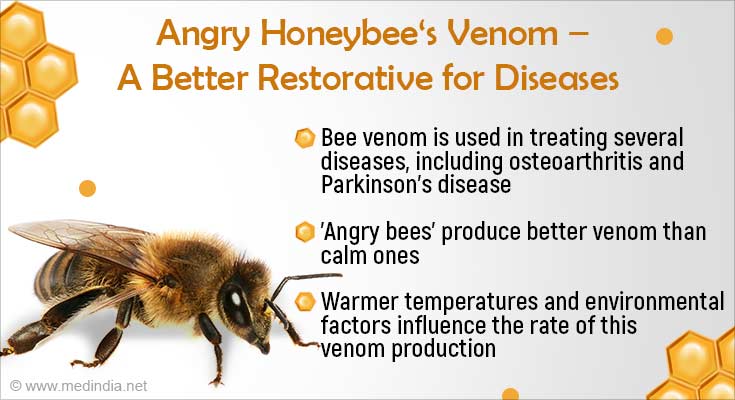that cushions the ends of the bones, especially due to aging.
that primarily affects movement due to the loss of nerve cells – neurons that produce a chemical messenger (neurotransmitter) in the brain called
PD affects one in 500 people, including about one million Americans and more than 10 million across the world suffering from the disease, as per the Parkinson’s Foundation.
It is characterized by muscle stiffness, slowness of movement, tremors, sleep disturbances, chronic fatigue, impaired quality of life, and can lead to severe disability.
It results due to the formation of inclusion proteins called Lewy bodies, triggered by the misfolding of a protein called alpha-synuclein that accumulates in a part of the brain called the substantia nigra.
The Study Data
The study team provoked up the so-called ‘angry bees,’ using electrical stimulating devices (a minimal shock-producing device). This allowed them to generate a richer, more protein-dense bee venom.
The study was viewed at domesticated honeybees, Apis Mellifera Ligustica, from 25 hives near Harvey in southwestern, Australia, and across multiple sites to distinguish almost 99 bee venom proteins.
Further, the study team affirms that this venom may aid in the fight against Parkinson’s and osteoarthritis.
The Venom of the Angry Honeybee
‘A compelling behavioral factor was revealed by the association between docile and active bees. Interestingly, we discovered that the ‘angry bees’ that reacted intensively to our stimulating devices produced a richer, more protein-dense bee venom,’ says the study’s lead author, Dr. Daniela Scaccabarozzi, from Curtin’s School of Molecular and Life Sciences.
Bee venom has been recognized for its healing properties for ages. It finds its effectiveness mostly in chronic injuries, as its enzymes and peptides are capable of treating the inflammation. They are also used in various central nervous system diseases, like Parkinson’s, Alzheimer’s, and others.
‘The overall quantity of venom released by bees relies on the alarm pheromone secretion that induces other bees to aggressively react by stinging. This may be a result of changes in genetics that can provoke aggression in bees,’ says Scaccabarozzi.
Factors Impacting the Bee Venom
The study also found that the warmer temperatures were found to result in ‘lower venom production. This suggests that seasonal factors cause a change in the protein profile of bee venom.
The optimal range for high protein diversity varies from 33 to 36˚C. Apart from temperature, the geographic location was also shown to impact the composition of the bee venom.
At one of the sites at Byford, Australia, it was found that a significant difference existed in bee venom compared to the two colder sites, Chittering and Harvey. These data conclude that exogenic site factors mandate further works for effective control of product quality and to devise cost-effective approaches for BV harvest.
Facts on Bee & its Venom
- Bee venom is also used for a variety of cases, including face creams and therapeutics.
-
The estimated price of bee venom has been reported to range from $30 per gram on the low-end to as high as $300 per gram, as per the Bee Venom Lab. - As these insects play a significant role as major pollinators, a recent decline in their figures has emerged as a global health concern.
- This is noticeably due to blended vulnerability to increased contamination from pesticides and poor nutrition.
-
Sugar is used as fuel flights by the bees to work inside the nest. - However, pesticides decrease their hemolymph (‘bee blood’) sugar levels and therefore cut their energy stores.
- The synergistic effect of limited food supplies deprives the bees further of their energy to function, thereby causing a downward curve in their causing survival rates.
- Bee venom has also been used in healing other conditions, like arthritis eczema, and some types of cancer.
References:
- Biological and therapeutic properties of bee venom
– (https://www.researchgate.net/publication/304011827_Biological_and_therapeutic_properties_of_bee_venom) - Chemistry and pharmacology of honey-bee venom [1986]
– (https://agris.fao.org/agris-search/search.do?recordID=US201301404800) - Therapeutic Effects of Bee Venom on Immunological and Neurological Diseases
– (https://pubmed.ncbi.nlm.nih.gov/26131770/)
Source: Medindia



